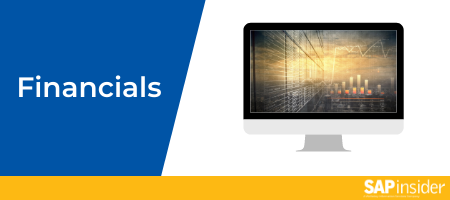Learn about the new line item browser report transaction codes in SAP S/4HANA Finance and how useful they are compared with the current line item report transactions codes.
Key Concept
Line item browser report transaction codes are available in SAP S/4HANA Finance only. These codes are not even part of the regular SAP system menu. SAP calls these transactions line item browsers instead of line item reports. These line item browser transactions speed up the closing process since they have various functionalities in terms of performance, download, and aggregation of data in different views.
In SAP S/4 HANA the new line item browser report transactions were not intended to replace the existing line item reports. Instead, they provide a new way of analyzing data. Depending on the layout you define, the report will display different values of aggregated information. They provide an overview of the relevant line item information.
You can then further drill down to get more detailed information of the actual line item data. These line item browsers also provide a lot of flexibility in viewing and downloading the data. There are some additional features of the current line item report (e.g., correspondence and mass change functionality) that are not available in the line item browser. Therefore, you can see that SAP is giving these new line item browser report transactions for additional analysis, but is not getting rid of the existing current line item report transactions.
The Benefits of Using the New Line Item Transactions
The line item browser transaction codes in SAP S/4HANA offer the following benefits to users:
- These transactions are easy to remember and have the same name as the current line item transaction codes except that the new transaction codes end with H.
- These new transactions are very fast in execution compared with the existing line item transactions (FAGLL03, FBL5N, and FBL1N).
- These new line item browsers transactions can be used to download the data while executing the report itself, unlike the current line item report that you have to download after executing the transaction and then select the data to save to a particular path or format.
- The data can be sent directly to the server while executing the transaction itself.
- Viewing the report gives new functionality by providing a hyperlink to the master data and document number. The new transactions also open the master data or document numbers in a different session without interfering with the existing report, unlike the regular line item transactions (FAGLL03, FBL5N, and FBL1N) in which the document display and master data are on the same screen.
Table 1 lists the new S/4HANA transaction codes for the line item browsers.
| S/4HANA transaction codes |
Description
|
Corresponding current line item transaction codes
|
Description |
| FAGLL03H |
G/L Line Item Browser (G/L View) |
FAGLL03 |
General ledger (G/L) account line items (new) |
| FBL1H |
Vendor Line Item Browser |
FBL1N |
Vendor line items |
| FBL3H |
G/L Account Line Item Browser |
FBL3N |
G/L account line items |
| FBL5H |
Customer Line Item Browser |
FBL5N |
Customer line items |
| GD20H |
FI-SL Line Item Browser |
GD20 |
FI-SL line items |
| KE5ZH |
PCA Line Item Browser |
KE5Z |
Profit center: actual line items |
Table 1
New SAP S/4HANA line item transaction codes in comparison with current line item transaction codes
Note
Transaction code FAGLL03 is used only if the SAP General Ledger is activated. If only the classic G/L is used, then use transaction code FBL3N. The process of executing and displaying these corresponding transactions using FBL3H is no different from transaction code FAGLL03H. Therefore, I do not cover the FBL3H transaction code. Transaction codes GD20H and KE5ZH are also used in the classic G/L, so I do not cover them. Just for information purposes I have provided the list of line item browser transactions corresponding to the current line item transactions. The key transactions I cover in this article are FAGLL03H, FBL5H, and FBLH.
Step 1. Display a G/L Account Line Item Browser (G/L View)
In this step I explain the inputs available in the selection screen after executing the G/L line item browser transaction code (FAGLL03H) for different views. The main purpose of showing the G/L Account Line Item Browser transaction code is to explain the new features available in S/4 HANA compared with the current line item report transaction codes.
Execute transaction code FAGLL03H. This action displays the screen shown in
Figure 1.
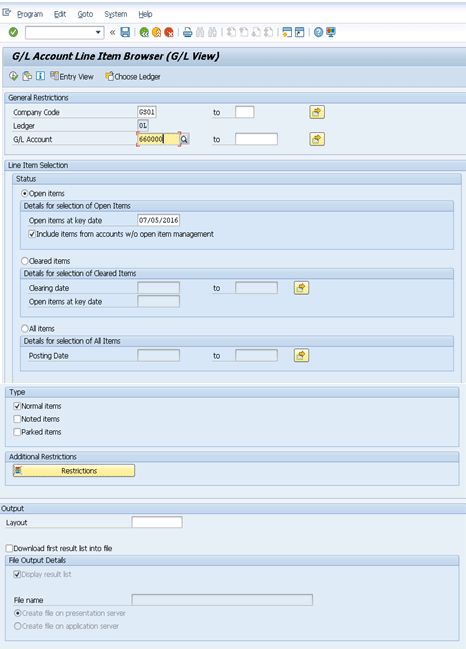
Figure 1
The G/L Account Line Item Browser (G/L View) input screen
Populate the Company Code and G/L Account fields and select the Include items from accounts w/o open item management check box. (Selecting this check box instructs the SAP system to include accounts without open item management and items while displaying the report.) Also enter a date in the Open items at Key date field and click the execute icon

.
After you click the execute icon, the system displays the account balance in line items as shown in Figure 2. By default the line item browser always shows the aggregated values, and it depends on how you have defined your fields for the current layout.

Figure 2
G/L account line item balances
The layout in Figure 2 is the default layout provided. Now you need to change the layout to bring the necessary fields to the layout. In the Document menu item, select the Change Layout… option as shown in Figure 3.

Figure 3
The Change Layout... option
Then system then displays the change layout screen as shown in Figure 4.

Figure 4
The G/L Account Line Item Browser (G/L View) screen display field’s selection
After selecting the Change Layout… option, you need to select the fields that need to be displayed while executing the report. I do not cover how each field is added to display options because this process uses standard functionality. The main purpose of this change layout selection is to display the option to select the fields required for display on the left as shown in Figure 4.
After you select the required fields, click the save icon. This action opens the screen in Figure 5 in which you need to enter a name and description for the layout.
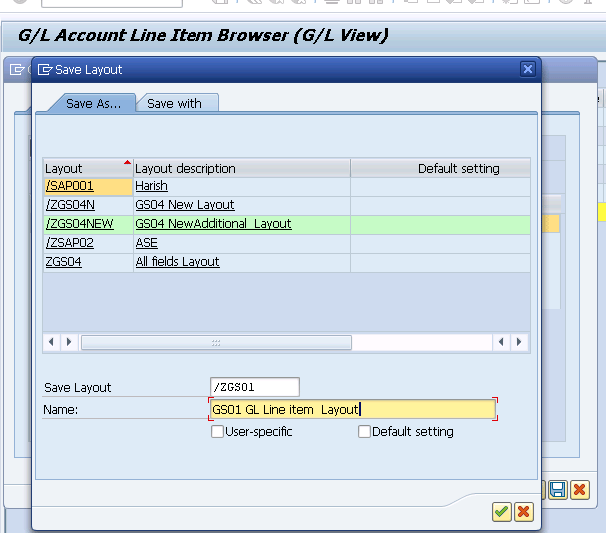
Figure 5
Enter a layout name and a description
After entering the name for the layout, click the green checkmark icon. The system then returns you to Figure 4. Click the save icon. The system then displays the layout as shown in Figure 6 with the respective fields in the layout. As you can see on the right side, the layout list is displayed with the split on the screen. With this you apply different layouts with a single click, which saves time for users where they need to quickly use different layouts.
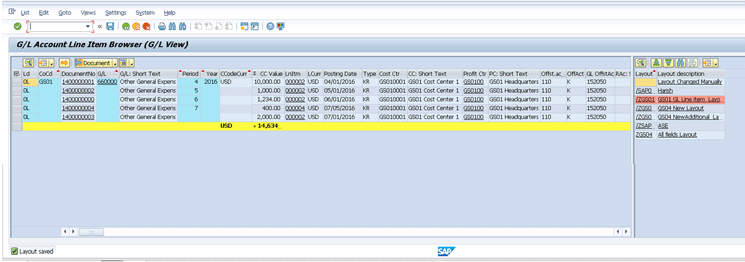
Figure 6
The layout saved and displayed
Some important fields that you can see in Figure 7 are for Document Number, G/L, LnItm (G/L line item), and Profit Ctr (profit center). All these underlined fields have hyperlinks. In the Layout column, you see a list of all the layouts. The layouts selection is easier than the standard line item report transactions, and it is one of the new features in line item browser transactions. It is easier to select whichever layout you want with one click since it is always displayed on the right side when the report is executed.

Figure 7
The G/L Account Line Item Browser (G/L View) screen with hyperlinks
Now click document number 1400000001 as shown in Figure 8. After you click this document, you see the following message appear at the bottom of the screen: Document will be displayed in a new window.

Figure 8
The G/L Account Line Item Browser (G/L View) screen with a document number
After you see the message in Figure 8, the system immediately opens another session and displays the document shown in Figure 9.

Figure 9
The document displayed in a new screen
This helps you keep the original report in the same session that you are working on and also view the document in another screen. This is the new functionality in these line item browsers that brings the document in a new session. Sometimes users want to see all the line items posted for a particular document so that they can see the overview of the accounting document. In the current line item report, you have to double-click the line item to view the document, but your original report displays the document. To return to the line item report, you need to click the back button twice.
Now go to the G/L column and click 660000 as shown in Figure 10. After you click this account number, you see the following message at the bottom of the screen: Selected information will be displayed in a new window.

Figure 10
The G/L account hyperlink in the G/L Account Line Item Browser (G/L View) screen
After you see the message in Figure 10, the system immediately opens another session and displays the G/L account master data as shown in Figure 11.
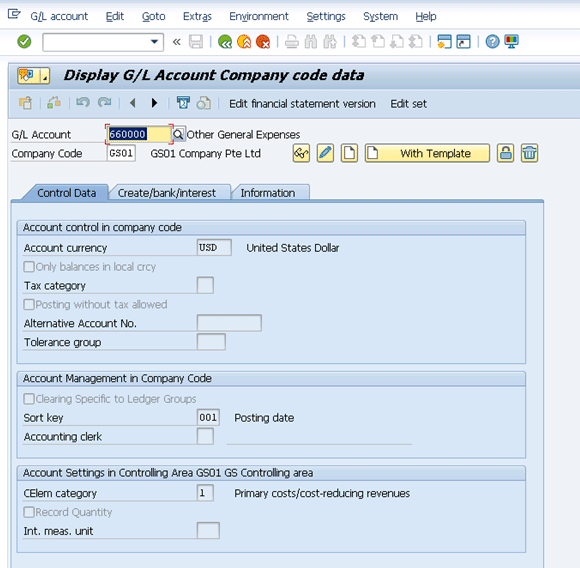
Figure 11
The G/L account display screen
Similarly, when you click a link in the Profit Ctr column, the master data of the profit center is displayed in another session.
Now go to the LnItm column and click document number line item 000002 of document number 1400000001 as shown in Figure 12. After you click this document number, you see the following message appear at the bottom of the screen: Document will be displayed in a new window.
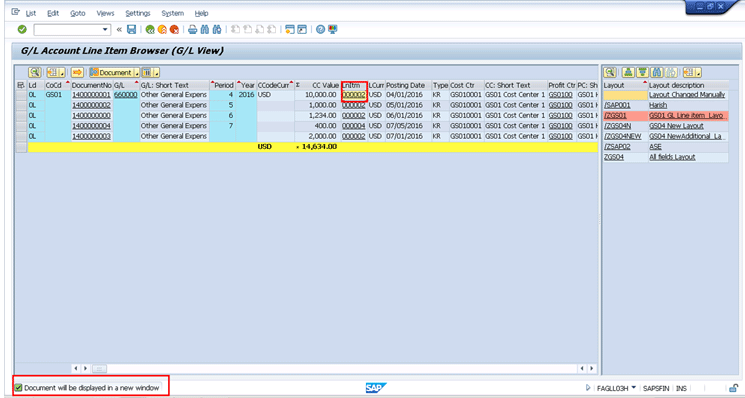
Figure 12
The G/L Account Line Item Browser (G/L View) screen with a line item number
After you see the message in Figure 12, the system immediately opens another session and displays the line item 2 of the document as shown in Figure 13.

Figure 13
The line item display screen
This helps you to keep the original line item report and also view the particular line item of the document only since you click the line item 0002 of the document number 1400000001 document in another screen. In the current line item report, you have to double-click the line item to view the document, but your original report displays the document. To return to the line item report, you need to click the back button twice.
Similarly, in S/4HANA, SAP provides an option to display documents in the same session or in a different session . Above you have seen all the scenarios in which the items are displayed in a new session. Click the Document button as shown in Figure 14.

Figure 14
The document selection display screen
In the Document menu, the system provides you with six options:
- Display Document
- Display Original Document
- Display Accounting Documents
- Display Document in New Window…
- Display Original Document…
- Display Accounting Documents…
If you click any of the first three options (Display Document, Display Original Document, and Display Accounting Documents), the system displays documents in the same screen instead of opening a new session in which to display them.
If you click any of the last three options, the system displays documents in another session screen instead of displaying them in the same session.
As you can see there are a lot of new options for viewing reports for analysis. You can also see that SAP has provided many fields for displaying the report in addition to the current line item reports. For example, in all master data elements, a description is provided instead of just numbers. When a report is displayed, you also see the description of the G/L account, profit center, cost center, and even the customer’s name and vendor’s name.
Step 2. Display G/L Account Line Item Browser (G/L View) Download Functionality
In this step I explain how to download the report directly while executing the report itself. The prerequisite to running this report is to have the layout saved with the required fields as shown in step 1.
Run transaction code FAGLL03H. In addition to what you have selected in step 1, you need to select the following:
- In the Layout field, enter /ZGS01
- In the File Output Details section, select the Display result list check box.
At the end of the File Output Details section, you have two options:
- Option 1: Create a file on the presentation server (this option is to save the file in a local drive or to your PC).
- Option 2: Create a file on the application server (This option is to directly send the file to the respective application server).
In my example I cover the first option as shown in Figure 15.
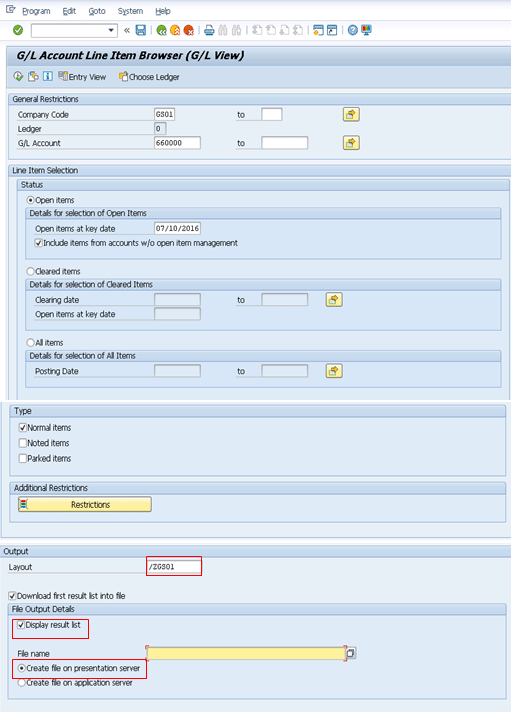
Figure 15
The G/L line item download input screen
After you enter data in the Company Code and G/L Account fields in the General Restrictions section, go to the Output section and enter the name of your layout in the Layout field (e.g., /ZGS01). Select the Download first result list into file check box and the Display result list check box. In the File name section select the Create file on presentation server radio button as shown in Figure 15. After you enter this data, click the input icon in the File name section to provide the path for the file name. Enter the path as shown in Figure 16 and then click the execute icon.

Figure 16
The G/L line item file path input screen
After you click the execute icon, the system displays the message shown in Figure 17. Press the Enter key or click the enter icon  .
.
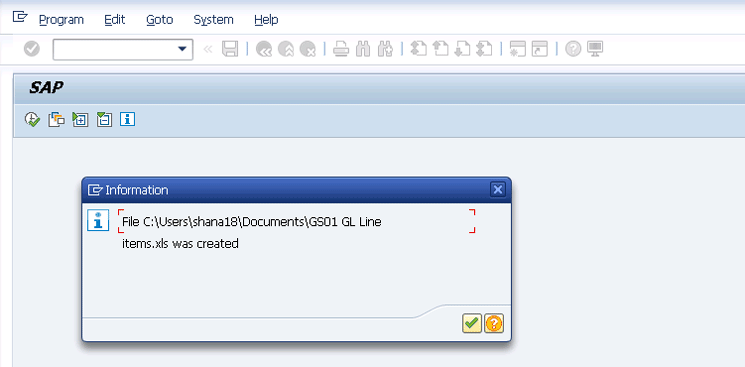
Figure 17
The G/L line item file download message
This action displays the report with the layout you have chosen in the initial screen of step 2 (Figure 18). Note that the system has generated the file at the location as shown in the message in Figure 17 and displayed the report as shown in Figure 18 simultaneously.

Figure 18
The default report layout displayed in the G/L Account Line Item Browser (G/L View) screen
This is one of the features that saves time for users because in the current line item report transactions users need to run the report, then, after displaying the report, they have to select the file to save it to the respective path. Since the line item browser report execution is fast in SAP S/4HANA, you can download reports quickly. Also an additional feature allows you to directly execute the report and send it to the application server, which was not possible in the current line item report transactions. You have to manually download the file and then again manually upload it to the respective application server.
To view the files generated, follow the path where the file is saved and double-click the files as shown in Figure 19.

Figure 19
The G/L line item file location
After you double-click the file, the system opens it and displays it in the specified format as shown in Figure 20. You can see that the file has all the fields as per your layout ZGS01.

Figure 20
The G/L line item Excel file display
Another additional feature in the new G/L line item browser is additional restrictions. About 340 fields are available to restrict data based on any criteria you can use (as shown in
Figure 21) for the list of fields available.

Figure 21
The G/L line restriction selection screen
Restrictions are very important when you want to further limit your selection criteria based on certain criteria. Let’s say you want to only line text items with the number 4000 to be reported. Previously, in the current line item report transactions, this functionality was called dynamic selection. Now in the new line item browser transactions, the functionality is called Restrictions. The icon is the same in both as shown in
Figure 22.
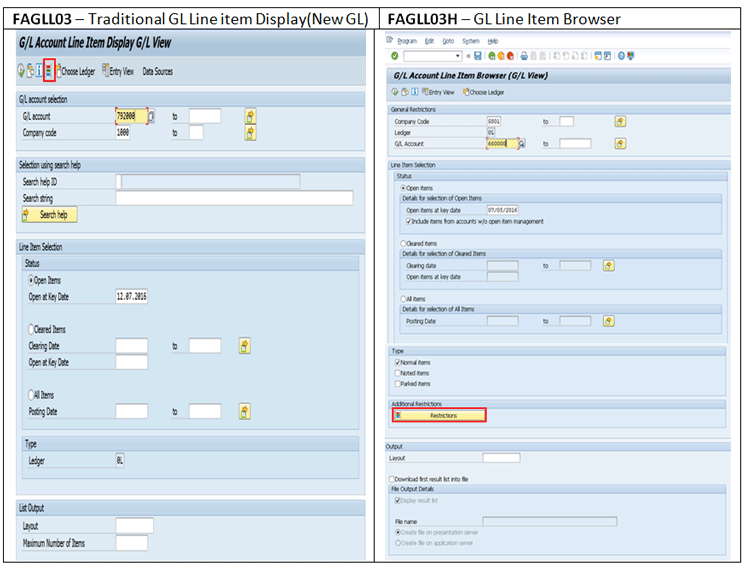
Figure 22
The G/L line item report comparison of FAGLL03 and FAGLL03H
Use transaction code FAGLL03H and in the screen the system displays, select the same selection as in step 1. Click the Restrictions button. The system then opens for further selection as shown in
Figure 21.
I do not cover each field. My purpose is to explain that there are more selection criteria available. For example, now the line item browser supports search string *4000* (including the ‘*’) for the document line item text. With this selection the line item browser output would only display data that has the phrase 4000 in the line item text.
Also in the
Figure 22 I compare both the new line item browser transaction (FAGLL03H) and existing line item transaction (FAGLL03). This comparison provides you with an overall idea of what the differences in the selection screen are between the two transactions.
Next, I show transaction codes FBL5H (Customer Line Item Browser) and FBL1N (Vendor Line Item Browser). Because I have gone through the details for transaction code FAGLL03H in steps 1 and 2 for saving the layout, downloading it, and additional features of the line item browser, I just cover the execution and display of these transactions, since all the features are same for the line item browsers.
Step 3. Display Customer Line Item Browsers
Execute transaction code FBL5H. In the screen the system displays (Figure 23), populate the Company Code and Customer fields. Enter the fiscal year date in the Open items at key date fields and then click the execute icon.

Figure 23
The Customer Line Item Browser input screen
After you click the execute icon, the system displays the account balance in line items as shown in Figure 24.

Figure 24
The Customer Line Item Browser report display
As you can see in Figure 24 the Customer number, Document number, and G/L accounts have hyperlinks. Most of the customer master data fields are available in the new line browser report. For example the customer address fields are displayed. As I previously mentioned these line item browsers have a lot of fields to display and descriptions of the master data elements are available.
Step 4. Display Vendor Line Item Browsers
Execute transaction code FBL1H. In the screen the system opens (Figure 25), populate the Company Code and Vendor fields. In the Open items at key date field, enter a date and click the execute icon.

Figure 25
The Vendor Line Item Browser input screen
The system now displays the account balance in line items as shown in Figure 26.

Figure 26
Account balance displayed in line items in the Vendor Line Item Browser screen
Most of the Vendor master data fields are available in the new line browser report. For example, the Vendor address fields are displayed.
Srinath Gogineni
Srinath Gogineni is working as an SAP FI/CO solution architect at Dynamic Enterprise Solutions Inc., providing consulting services to various clients. He is an SAP-certified FICO consultant with more than 15 years of experience in SAP financials. Previously he worked as a full-time employee for Hospira Inc. and Fenwal Inc. His main areas of expertise are in FI/CO areas such as G/L, SAP General Ledger, New GL, AR, AP, intercompany, FSCM, taxes, integration with Vertex, profit center, CO, CO-PC , CO-PA, SAP S/4HANA Finance, business process improvements and integration with other modules. He has worked on various complex projects and multiple global rollouts.
You may contact the author at
srinath.sapfico@gmail.com.
If you have comments about this article or publication, or would like to submit an article idea, please contact the
editor.





























